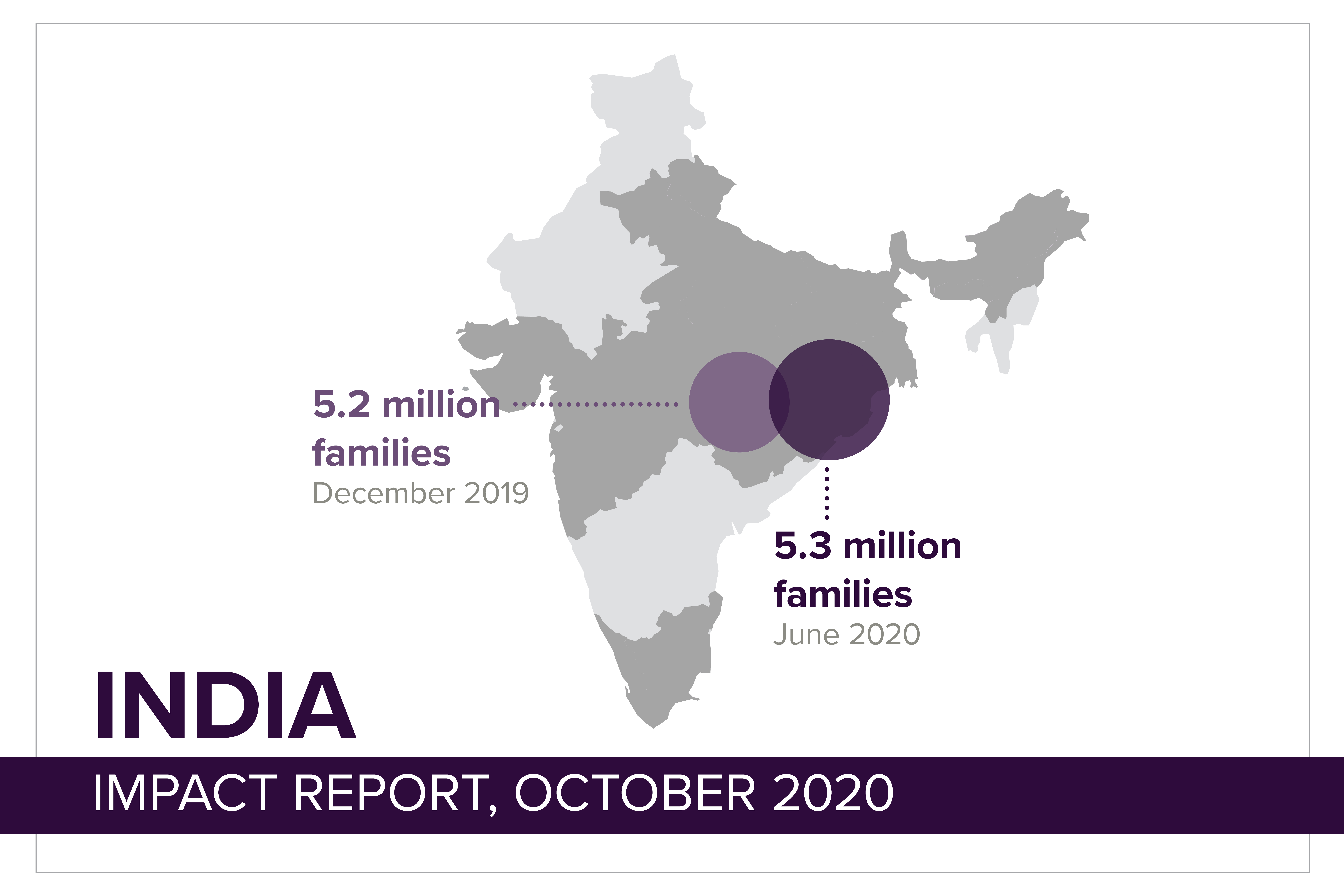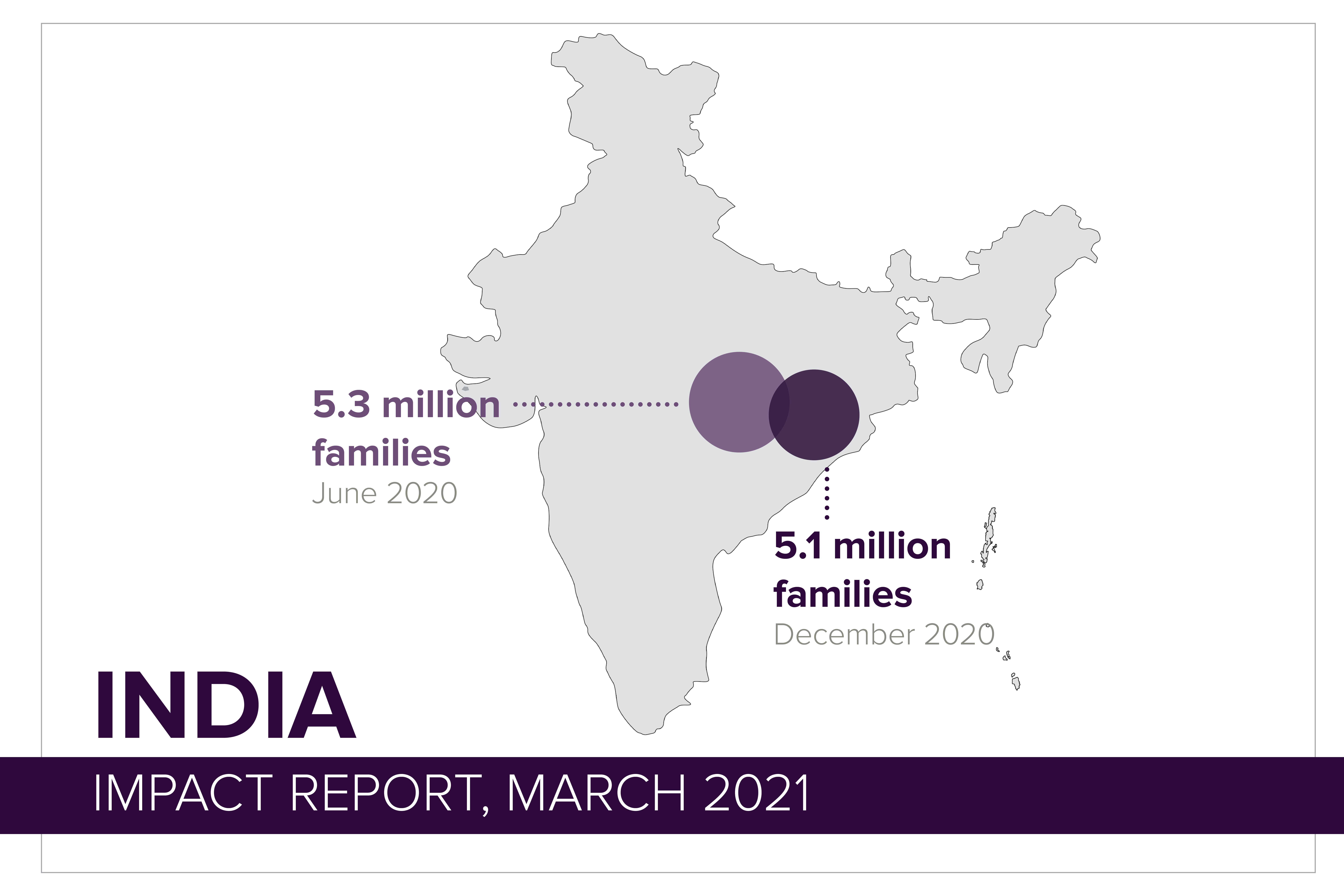Data to June 2021
During the second wave of COVID-19 in India, beginning in March 2021, recorded deaths reached 4,000 per day, with illness spreading to regional areas and greatly impacting the rural economy.
States imposed two-month lockdowns that hampered loan collections; many businesses that had held on through 2020 lacked the resources to deal with 2021. Even before that, 75 million more Indians were plunged into poverty in 2021.1
By May 2021, the second wave of the pandemic had reached its peak. India became the epicentre with more than 400,000 new cases reported in a single day. The nation had recorded 27 million cases by late May.
To support the overwhelmed healthcare system, Opportunity worked swiftly with existing and new partners to plan a rapid response. Microfinance institutions provided extensive networks and established trusting relationships which enabled us to reach vulnerable people with supplies, support and vital information, even at the last mile. (Read more about our five-pronged approach in the Health Impact Report.)
The microfinance sector has not been as severely affected by this wave as by the first in 2020. Larger MFIs are accessing market funds and smaller MFIs are endeavouring to raise funds aggressively to maintain fiscal health. Collections improved as lockdowns eased, although credit costs may rise. Standard & Poor expects India’s economy to rebound by 9.5 per cent this financial year, the Reserve Bank of India asked all MFIs to provide their borrowers with restructuring options and the government announced that it will guarantee 75 per cent of banks’ new loans to MFI borrowers.
Opportunity’s clients, demonstrating extraordinary resilience, pivoted, and pivoted again, despite situations amplified by illness and fear. They are rebounding. Markets are slowly opening up and festival season is approaching, with the promise of increased trade along with concern over another possible wave. But vaccines could make the difference, as more than a third of India’s 1.4 billion people had received at least one dose by mid-year.
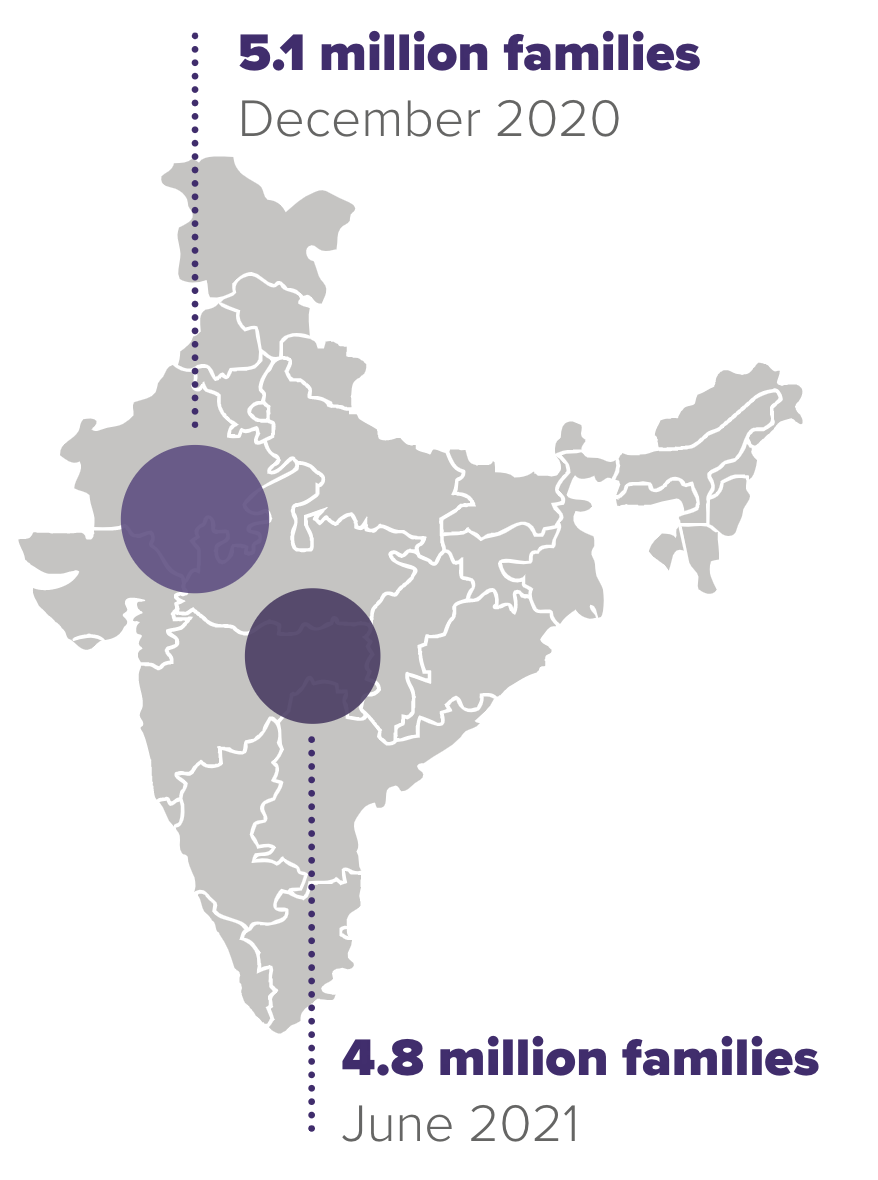
Partner performance
Over the last six months, all but one of Opportunity’s Indian partners have seen a reduction in client numbers.
The situation in India remains fluid and we are closely monitoring and working with each partner, where possible, to maximise their opportunities and abilities to move on from pandemic-induced contraction. There are also green shoots of hope to report.
The pandemic saw microfinance institutions step in to provide vital support to communities. Cashpor now provides health services to nearly a million clients through its network of 336 mini health clinics and 84 telehealth Doctor on Call clinics. Cashpor also runs 1,178 education centres in 28 regions of five states, benefiting 35,175 children. And the microfinance institutions impact assessment shows that 40 per cent of Cashpor clients have moved out of extreme poverty (now > US$1.25/day) since joining the microfinance institutions programs, with 94 per cent seeing a decrease in poverty likelihood.
The longer the relationship between the client and Cashpor, the higher the likelihood of them moving out of poverty. (For more social performance management updates, see below.)
Satya is one of the best performing of Opportunity’s partners in India and has achieved an A rating from Agents of Impact for their contribution to the United Nations Sustainable Development Goals. (See our case study below for a more in-depth look at Satya.)
Pahal is currently revising their social performance management policy, combining social and environmental policies and revised social goals. Pahal has also been awarded the Best Innovative Financial Accessibility Model for its sanitation program in 2021 by the Indian Sanitation Coalition and the Federation of Indian Chambers of Commerce Industry.
India Microfinance Partner Summary
|
|
Families Reached |
Loans Outstanding A$'000 |
Operational Sustainability3 |
Portfolio at Risk > 30 days3 |
|---|---|---|---|---|
|
ESAF & |
2,830,689 | $1,814,080 | 103.54% | 17.83% |
CASHPOR |
1,045,384 | $572,843 | 123.32% | 1.28% |
SATYA |
500,793 | $245,314 | 107.76% | 6.42% |
PAHAL |
317,582 | $120,021 | 103.94% | 6.68% |
ADHIKAR |
91,250 | $23,179 | 102.40% | 3.28% |
| GO FINANCE |
74,819 | $21,917 | 83.38% | 43.74% |
PRAYAS |
19,025 | $7,448 | 139% | 4.11% |
| Overall | 4,879,542 | $2,804,802 |
Portfolio at risk (PAR) is a stringent measure of a microfinance institution’s loan portfolio quality. The portfolio at risk calculates the total value of outstanding loan balances for loans, for every payment that is overdue by more than 30 days. Operational self-sustainability (OSS) is the ability of an organisation to cover the costs of its lending program with the revenue earned from its lending program.
All partner microfinance institutions are sustainable except Go Finance.Portfolio at risk percentages reflect the hardships of the COVID-19 pandemic. NESFB, situated in the north-east of India, has been subject to political interference in the state due to local elections which disrupted collections. Since the March 2021 report, Opportunity has disengaged from Sanbandh, Samhita and Shikhar. Margdarshak has been excluded from the table as reporting as at 30 June 2021 can’t be verified.
Social performance management update
Opportunity’s Social Performance Management (SPM) team exists to ensure that our partners are meeting clients’ needs efficiently and effectively.
We are committed to supporting our partners to strengthen their practices to industry best. To assist them in understanding and honouring their obligations, a new client protection pathway has been developed to implement client protection standards, replacing the old pass/fail system with tiered bronze, silver and gold certification.
In line with increased operational digitisation and transparency, seven Opportunity partners in India (Adhikar, Cashpor, ESAF SFB, Go Finance, NESFB, Pahal and Satya) are now recording social performance measures using SPI4 Online, a platform used by financial service providers, investors, consultants, networks and national associations.
This means we can now report financial and operational data from these partners to a centralised reporting system with industry benchmarking. Incorporating data from SPI4 helps Opportunity monitor and evaluate our partners and allows them to benchmark their operations with their peers.
Additionally, the Universal Standards for Social Performance Management (USSPM) is a six-faceted approach to ensuring that MFIs treat clients, staff and other stakeholders responsibly while delivering their services in an ethical manner. Opportunity partners are reporting high compliance with USSPM practices and excellent results benchmarked across Asia.
CASHPOR client poverty - change over time
Cashpor surveyed 10,460 clients in 2019, comparing their poverty levels to that at the time of joining Cashpor’s programs.

- 40% of clients have moved out of extreme poverty (>$1.25/day)
- 12% of clients live above $2.50/day (considered as the moderate poverty line,compared to less than 1% at the time of joining)
- 94% of clients have seen a decrease in poverty likelihood, with the remaining seeing an increase
- The longer the relationship of a client with Cashpor, the higher the likelihood of the client moving out of poverty
Voice from the program
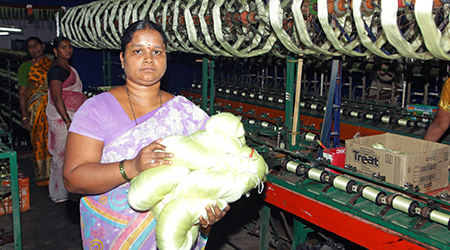 With the help of ESAF, former factory worker Sunita now owns her own factory.
With the help of ESAF, former factory worker Sunita now owns her own factory.
"Realising an impossible dream"
For a factory worker, opening a factory of her own seems like the impossible dream, but Sunita Suresh, together with Opportunity partner ESAF, has made her dream real.
After her marriage, Sunita worked in a silk reeling factory, creating silk threads from multiple filaments, alongside her husband Suresh and his father Subbaiah who had both worked there for many years. Always keen to learn, Sunita gained more and more knowledge over 12 years and was willing to take the leap of faith needed to start her own business but lacked the money to realise her dream.
She learned about ESAF and its microloans in 2015, and could finally access the funds she needed. Initially, she purchased raw materials along with energy efficient machines and she – and her team – now supply silk yarn to handloom operators in neighbouring Tamil Nadu. She works hard and has become a role model, inspiring the next generation to succeed.
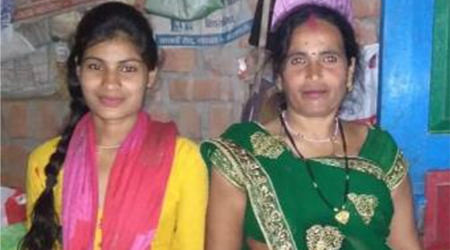 Cashpor client Geeta’s daughter Ankita has had her health restored thanks to Cashpor’s Doctor on Call service.
Cashpor client Geeta’s daughter Ankita has had her health restored thanks to Cashpor’s Doctor on Call service.
"Telehealth through my lender ended our pain"
With extensive established networks and existing trust-based relationships, microfinance institutions were perfectly placed to deliver healthcare during the pandemic.
When Geeta Devi’s 22-year-old daughter Ankita began suffering itching and pain in her legs, she consulted one doctor after another, but none could provide relief. Then Geeta heard about telehealth sessions run by Cashpor, her trusted lender of many years, through an e-clinic program. The Cashpor Doctor on Call soon diagnosed Ankita’s problem, sent a prescription to her mobile phone and after her course of treatment, Ankita was finally free from pain.
Geeta says, ‘I feel privileged that I have been associated with Cashpor for a very long duration – their services indeed help below-poverty-line women like us to uplift ourselves from poverty by minimising our costs spent on health. We are thankful for the difference Cashpor is making.’
Case study
Satya MicroCapital: Digital repayments
The digitalising of MFI operations was expedited by COVID-19. For lenders, where face-to-face collections haven’t been possible because of lockdowns, converting borrowers to digital repayments has been key to remaining liquid. Satya MicroCapital has been promoting cashless payments since its inception in 2017.
Among the fastest-growing MFIs in India, Satya has more than 500,793 borrowers served by 183 branches in 156 districts of 21 Indian states. Eighty-eight per cent of Satya clients live below the poverty threshold and 99 per cent are women.
Satya offers group loans, individual loans and health and life insurance products, along with special COVID-19 insurance. Satya also runs a COVID-19 helpline for clients and staff and has distributed around 10,000 medical kits, 6,000 masks and 1,200 sanitisers to those in need. Added to all that, it is certified as a Great Place to Work by the Great Place to Work Institute.
As well as being vulnerable to lockdowns, in-person cash repayments can be inefficient. As more and more people from rural and remote India gain access to smartphones, digitisation benefits clients directly by improving transparency and preventing fraud, and improves operational efficiency by up to 30 per cent. Satya now has six channels for cashless payment – a one-stop solution for clients.
Satya takes it much further than that, though. Onboarding new clients – onerous for financial institutions – has been streamlined through artificial intelligence, facial matching, automated data extraction and machine learning techniques. Customers benefit from reduced turnaround times and it has slashed onboarding costs for the MFI.
Moving into the future, Satya intends to become a 100 per cent paperless organisation with an online electronic signature service linked to each client’s government-issued Aadhar (identification number). Clients will be able to conduct every transaction on smartphones – a new era for microfinance in India.
1 https://www.ft.com/content/0ea25486-5b47-4a07-8d63-34e8d0dec208
Impact Stories
Your support is empowering these women—and millions more like them—to create a new future for their families, free from poverty.
Small loans change lives, and now they can build a sustainable future through green businesses.
A pilot project, run by Cashpor, is working with our established microfinance clients to take part in reforestation projects across India’s north.

“This is my dream, to help women who are in need by giving them work in my shop.”
– Sangeeta, Nagpur
Thanks to a small loan, Sangeeta’s dream of starting her own tailoring business came true.

Shivali and Savitri – friends, neighbours and two women committed to building healthier villages in India.
Opportunity is dedicated to seeing women empowered through microfinance, as well as health, safety and education.

Microfinance is a complex humanitarian intervention. It is also a sector that is experiencing great change. Mark Daniels, Opportunity International Australia’s Asia Programs Director, explains.

In this second instalment on microfinance, Mark Daniels, Opportunity’s Asia Programs Director, explores the changing nature of microfinance and the challenges that lie ahead.
